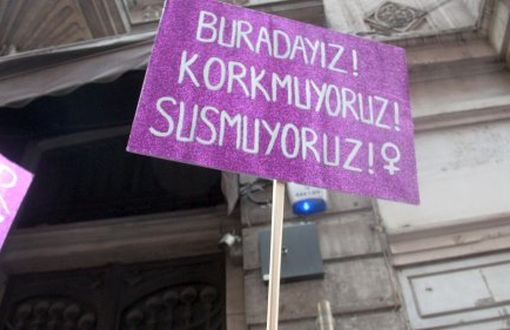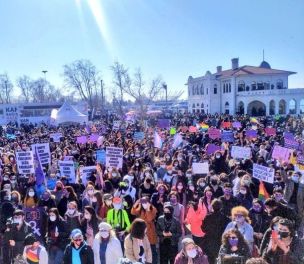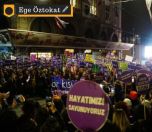EVRİM KEPENEK
'Child abuse, male violence have increased during pandemic'

"We are here, we don't fear, we don't hush" (by Evrim Kepenek - bianet)
Since 2008, bianet has been preparing male violence monitoring reports based on the news reported in the press. Scanning the local and national newspapers, news websites and agencies, bianet Male Violence Monitoring Reports have been compiling news on male violence.
While Ege Öztokat has been contributing to the preparation of the reports by scanning the news on a daily basis since October 2019, bianet Women - LGBTI+ editor Evrim Kepenek has been preparing the reports.
In an interview to the Equality, Justice, Woman Platform, Evrim Kepenek has detailed the outcomes and the preparation process of the male violence monitoring reports as well as male violence in Turkey.
Some highlights from the interview are as follows:
'A challenging process, but reports are vital'
Could you tell us  about the outcomes and preparation process of the male violence monitoring report?
about the outcomes and preparation process of the male violence monitoring report?
Before the preparation process of the report, I would like to mention something else briefly. Our report is entirely focused on male violence and includes killings and violence. It collects data month by month.
For example, if we say that men killed 36 women in March 2021, it means that all murders were committed in March. If he was killed in February and was reported in the press in March, that murder is not included in the number. It is added as "reflected" in March.
I would also like to note that there is a process that has been established at bianet regarding the preparation of the report. This system was founded by Emine Özcan, Burçin Belge and dear Çiçek Tahaoğlu who took this position before me. Even if we add new things to the content according to the current developments, I generally proceed according to this established method.
Our colleague Ege Öztokat examines all the news about violence via media follow and google alert. Ege spares the content that contains violence committed by men and selects those that can be included in our report. I receive a summary of about 30-50 pages each month. I prepare the tally based on this summary. [...] Also, our friend Yağmur Karagöz prepares the infographics so that they reach a wider audience.
Of course, it is a backbreaking and challenging process, especially from a psychological point of view. Because you finish the day reading these sentences: "Her husband burned Ayşe, who went to the market", "Her brother crushed Aisha's head with dumbbells when she did not give the money". But I think both the Femicide Platform's and our reports are vital.
'Child abuse, male violence have increased'
If we look at the last year as a journalist (if any), what do you think are the effects of the pandemic, is there any difference regarding your reports from the past years?
I can clearly say that child abuse and male violence have increased. Both the data of the bianet monitoring reports and the reports prepared by many non-governmental organizations demonstrate this.
For example, law enforcement officers did not perform their duties on the pandemic's pretext, and the courts were suspended. Moreover, men who committed violence were released. We know that men also commit violence after they are released from prison.
'Violence begins and ends in language'
In one of your interviews, you said that the peace process had a positive effect on femicide. Why is peace essential, and how do you interpret its relationship with femicide? In addition to this question, you talk about peace journalism and gender perspective in your work. What role do you think these perspectives play in violence against women, what kind of transformation can they make?
So, we know that violence begins and ends in language. For example, suppose we want to make the perpetrator visible. In that case, we say, "the man named Ahmet killed Ayşe." Assume we want to overshadow the violence and make it invisible. In that case, we can say, "the 35-year-old beautiful mother of two children was killed by Mehmet, who had economic problems because he was unemployed." In other words, the language we use tells us the dimensions and the truth of violence. If we want to prevent violence, we use language accordingly. However, unfortunately, the violence in the language is mainly produced by politicians.
The tension in male politicians' speeches, who are followed by the public, deemed important by a large part of the society, is obvious. But when politicians use a non-polarizing language, its effect also spreads to the whole society. Data on male violence during the peace period shows us this clearly.
Violence towards women does not only come from husbands and lovers. Patients' relatives use violence against doctors, clients are violent to lawyers, and sometimes passengers use violence on a bus to a bus driver.
I believe that the language of violence has a feature of invoking violence, which I call the domino effect of violence. If we reverse the equation, we want peace to have a domino effect, and I present the language of peace as a humble suggestion to politicians and the general public. (SD)
* Click here to read the full interview





